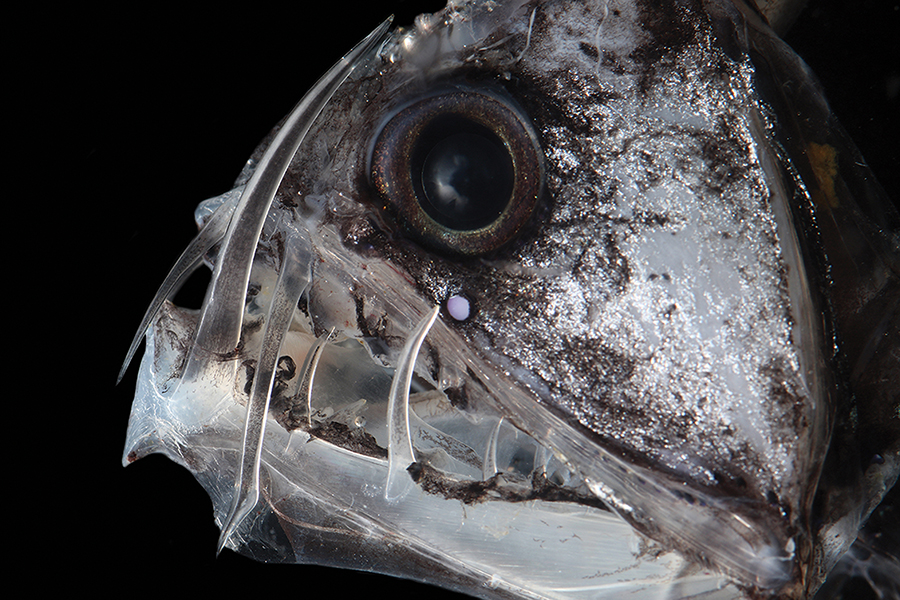
In the Realm of Seadevils
Encountering wonders from the deep-sea
Story and Photographs by Todd Pusser
A crescent moon hung high in the sky over a sea as smooth as glass. The air was thick with humidity as our research vessel plowed slowly through the waters of the Gulf Stream 150 miles south of Cape Cod. Thousands of stars twinkled above while lightning danced across distant thunder clouds miles away. Below my feet, it was a mile and a half down to the ocean floor.
The steady sound of the massive winch suddenly stopped. The thick cable extending out from the stern, taut with tension, indicated that the deep water trawl net was close to the surface. Like a kid on Christmas morning, I could barely contain my excitement. You never know what you might catch when dropping a net far below the ocean’s surface. On this particular trawl, the net was towed around 1,500 feet deep. Chances are good you might catch something that has never been seen by human eyes.
The deep-sea is defined as waters below 660 feet, where sunlight no longer penetrates. At its most extreme point, the ocean is an astounding 36,201 feet deep — roughly 7 miles down. At those depths, the ocean is a pitch-black wilderness where temperatures hover just above freezing.


Left: Deepsea Shrimp.
Right: Black Sea Devil-humpback anglerfish.
It is not hyperbole to say that more is known about outer space than the deep-sea. The ocean covers 70 percent of this planet, and on average, is nearly 2 ½ miles deep. As pointed out by author Helen Scales in her recent book, The Brilliant Abyss, the entire surface of the moon has been mapped to a resolution of 23 feet, while the deep ocean floor that blankets the Earth has only been mapped to a resolution of 3 miles.
As a kid, on family vacations to Cherry Grove in North Myrtle Beach, I would often find myself standing on the sandy shore and staring out over the ocean, trying to look past the horizon line and wondering what treasures lay hidden beneath. In middle school, I daydreamed of being Captain Nemo, from Jules Verne’s classic Twenty Thousand Leagues Under the Sea, piloting the wondrous deep-sea submarine Nautilus in search of sea monsters. Later, in college, I discovered real-life explorer William Beebe, who in 1930 became the first man to descend into the dark depths of the ocean, below the reach of light, using a large steel sphere lowered from a stationary ship by thousands of feet of steel cable. Beebe introduced the wonders of the deep to people around the world in a series of articles for National Geographic and popular books such as Half Mile Down. I never imagined at the time that I would be able to see some of the wondrous creatures Beebe described in his writings.
With a few final turns of the winch, the net was hauled onto the deck of the ship. Grabbing a hard hat and life vest, I walked out onto the stern to assist the fishery biologists in sorting the catch. Down on one knee, I began to pick through a cornucopia of our planet’s strangest inhabitants — creatures that look like they evolved from the mind of Dr. Seuss. Even their names evoke a Spielbergian science fiction epic: dragonfishes, greeneyes, lanternfishes, whalemouths, hatchetfishes, bristlemouths, star-eaters, gulpers. Many were velvet black with mouths full of huge teeth and possessed strange, glowing bioluminescent lures sprouting from their heads. There were bright red shrimp, glowing squid, and skinny eels with bird-like beaks.
I reached into the twine of the net and gently untangled a saber-toothed viperfish, which possessed a series of needle-sharp fangs that extended up from its lower jaw to just above its eye. A series of bioluminescent dots ran along its flanks while an elongated glow-in-the-dark lure extending from its dorsal fin dangled in front of its fearsome maul. When viewed only in a photograph, a viperfish would appear to the be most fearsome critter in the sea. Thankfully it grows only to a foot in length, as do the vast majority of the monstrous looking fishes from the deep.
Farther down the side of the net, I find another unusual fish, the fangtooth. Sporting a face only a mother could love, the 5-inch-long predator comes equipped with a massive mouth full of oversized teeth that are capable of tackling prey nearly as large as itself.

Viperfish
Suddenly, there is an exclamation of excitement from a biologist standing nearby. We all rush over to discover the ultimate prize in tonight’s haul: a small female humpback anglerfish commonly known as the black seadevil. Looking a bit like a demonic tadpole, she seemed to be all head with a rotund black body, huge mouth, big teeth, and a stout, rod-shaped lure that extended up from the top of the head, which was capped by a glowing, bacteria-filled light organ known as an esca. Scientists speculate the lure may be used to attract prey close to her vicious mouth — or perhaps to draw in a mate.
The deep-sea is vast, the largest livable space on the planet, and it may take years to find a mate. There are around 170 species of deep-sea anglerfish currently recognized by science, and many deploy a most remarkable reproductive strategy. Male anglerfish lack bioluminescent lures and are many times smaller than females. In several species, when a male finds a female, he literally latches onto her skin, like a tick. Once attached he never lets go for the rest of his life, taking “till death do us part” to a whole other level. Eventually, he fuses with her tissue and gains sustenance from her bloodstream. He is entirely dependent on the female for survival. In return, he provides her with a never-ending supply of sperm.
The abyss is unfathomable, a place beyond comprehension for us landlubber humans. Countless creatures that defy imagination still await discovery in its dark depths. I, for one, feel extremely privileged to have experienced some of its treasures firsthand. PS
Naturalist and photographer Todd Pusser grew up in Eagle Springs. He works to document the extraordinary diversity of life both near and far. His images can be found at www.ToddPusser.com.





